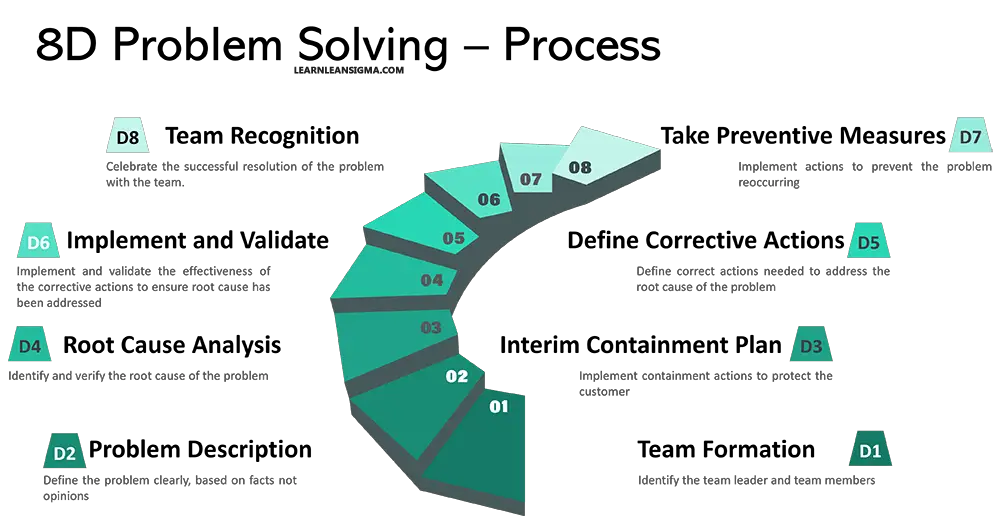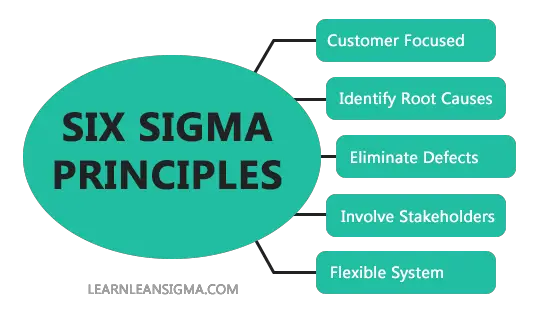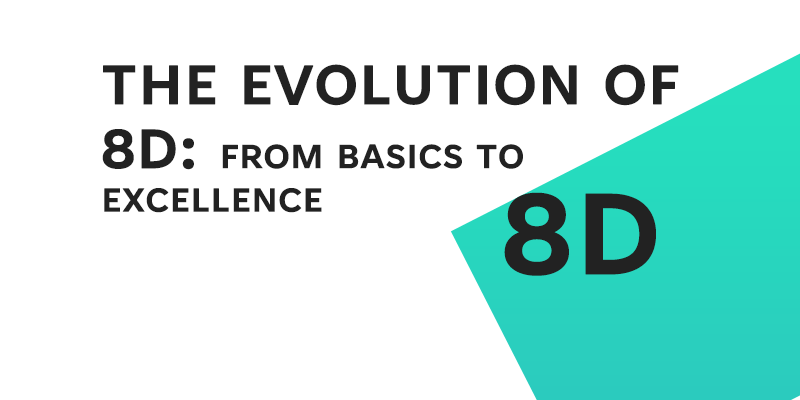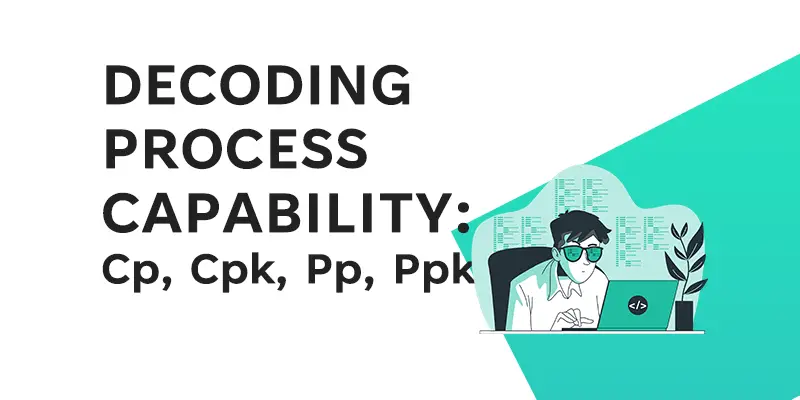In a world where efficiency and effectiveness are more than just buzzwords, the need for robust problem-solving methodologies is greater than ever. Among the myriad of approaches that organizations adopt to tackle challenges, the 8D Problem-Solving framework stands as a testament to both versatility and efficacy. Originating from military standards and later popularized by the automotive industry, 8D has evolved to become a universal tool for identifying issues, analyzing root causes, and implementing sustainable solutions.
This blog post aims to guide you through the captivating history and evolution of the 8D Problem-Solving approach. From its early days as a checklist in quality management to its modern adaptation using advanced statistical tools and cross-industry applications, we’ll explore how 8D has transformed into a comprehensive, adaptable, and highly effective method for tackling problems in various sectors. Whether you’re new to 8D or looking to deepen your understanding, this article offers valuable insights into its development and current applications.
The Genesis: Where It All Began
The Military Origins
The very first seeds of the 8D Problem-Solving methodology were sown during World War II. It was incorporated into Military Standard 1520, a framework aimed at addressing product and service failures. At the time, the military faced complex challenges that often involved multiple variables and high stakes. These challenges required a disciplined approach to problem-solving that could help identify and eliminate the root causes of failures.
Limited Initial Reach
Despite its structured approach, the method had limited reach and was not extensively used outside military applications. This was primarily due to two reasons:
- Specificity: The original framework was tailored for military applications, which made it less relatable to civilian industries.
- Complexity: The depth of the method often required specialized training, which acted as a barrier for broader adoption.
The Automotive Revolution: Ford Takes the Wheel
Fast forward to the 1980s, and the landscape of quality management began to change. Companies were increasingly focusing on systematic approaches to problem-solving and continuous improvement. It was during this era that the 8D Problem-Solving approach got a second life through its adoption by the Ford Motor Company.
Ford was facing growing competition and realized the need for a structured, repeatable problem-solving methodology. The 8D framework fit the bill perfectly, as it provided a step-by-step approach to identify issues, analyze their root causes, and implement corrective measures.
Standardization and Beyond
Once Ford demonstrated the success of implementing the 8D methodology, it became part of the larger Quality Management Systems. Organizations began to see the value in a disciplined approach to problem-solving, and thus, 8D started its journey towards standardization and broader industrial application.
By embracing quality management principles like ISO 9001, the 8D approach transformed from a ‘military-specific’ solution to a universally applicable method for problem-solving. This was a pivotal moment in its history, paving the way for the methodology’s future evolutions and its adoption across diverse sectors.
The origin story of 8D Problem-Solving is a compelling tale of adaptation and evolution. From its military roots to its mainstream industrial applications, the methodology has proven its mettle in solving complex problems methodically and effectively.
The 8 Disciplines: A Quick Overview
Understanding the 8 Disciplines that make up the 8D Problem-Solving approach is crucial for comprehending its comprehensive nature.
For a comprehensive guide on how to navigate each of the eight disciplines, you can visit Learn Lean Sigma’s 8D Problem Solving Guide.

Here’s a brief rundown:
D0: Plan
This is the preparatory stage where you outline the scope of the problem and plan the resources required for the problem-solving process.
D1: Team Formation
A cross-functional team is assembled with individuals who have the skills and knowledge needed to solve the problem effectively.
D2: Problem Description
The issue at hand is clearly defined, often using tools like the 5W2H (Who, What, When, Where, Why, How, How much) to ensure everyone understands it.
D3: Interim Containment Actions
Temporary actions are taken to contain the problem and prevent it from causing immediate harm while the root cause is being investigated.
D4: Root Cause Analysis
Through data collection and analysis, the underlying cause of the problem is identified. Methods like the Fishbone Diagram or 5 Whys are commonly used.

D5: Permanent Corrective Actions
Once the root cause is known, permanent solutions are developed and tested to ensure they effectively solve the problem.
D6: Implement and Validate Solutions
The validated solutions are fully implemented. Metrics are set up to monitor the effectiveness of the solutions over time.
D7: Preventive Measures
Actions are taken to prevent the recurrence of the problem in the future. This often involves updating procedures or training.
D8: Closure and Team Celebrations
The project is formally closed, and the team’s efforts are recognized and celebrated, often leading to increased motivation for future projects.
These eight disciplines provide a structured, step-by-step approach to problem-solving, ensuring that issues are not just solved but also prevented from recurring.
Would you like to know how each of these disciplines integrates with modern tools and methodologies like Lean Six Sigma? Stay tuned for more in-depth articles on this topic.
The Evolutionary Milestones of 8D Problem-Solving
1. Initial Adoption and Standardization
The Checklist Era
In its formative years, the 8D methodology was primarily a checklist approach to problem-solving. Organizations used it as a guide to ensure that they didn’t miss critical steps in the problem-solving process. While effective, it lacked the rigor and structure to be universally adopted as a standard.
Integration into Quality Management Systems
The game-changer came when 8D was integrated into Quality Management Systems like ISO 9001. This move provided the methodology with the structure and standardization it needed to be widely accepted. It moved from being a simple checklist to a deeply structured, documented process that required evidence-based actions at every stage.
2. Cross-Industry Application
Breaking Industry Barriers
By the late 1990s and early 2000s, the 8D methodology began to show its versatility. What started in the automotive and military sectors soon found applications in healthcare, FMCG, logistics, and even software development.
Universal Principles
The universality of its principles meant that it could provide a structured way to approach problem-solving in different settings. The discipline it instilled in the process made it a favorite across industries, proving that good problem-solving techniques are not confined by industry boundaries.
3. Integration with Other Methodologies
The Synergistic Approach
In more recent years, 8D has been combined with other methodologies like Six Sigma, Kaizen, and Lean. This integration has made the process far more robust, marrying the structured approach of 8D with the data-driven and continuous improvement aspects of these methodologies.
Enhanced Problem-Solving
For instance, integrating Six Sigma techniques into the Root Cause Analysis stage (D4) has allowed for a more sophisticated and accurate identification of root causes, making the solutions more effective and sustainable.

4. Technological Enhancements
The Data Revolution
The advent of advanced statistical tools and software has significantly impacted the 8D methodology. Data analytics platforms and specialized software have made the data analysis phase far more sophisticated, improving the accuracy and efficiency of the entire process.
5. Adaptation for Smaller Issues
Quick 8D and Micro 8D
Recognizing that not every problem requires a full-blown 8D approach, the methodology has been adapted into “Quick 8D” or “Micro 8D” versions. These are less resource-intensive and can be implemented much quicker, making 8D accessible for smaller issues without sacrificing the integrity of the problem-solving process.
The 8D Problem-Solving methodology has shown remarkable adaptability and resilience, evolving over the years to meet the demands of a rapidly changing industrial landscape. Each evolutionary milestone has added layers of effectiveness, making it a reliable choice for organizations aiming for excellence in problem-solving.
Modern-Day Applications and Case Studies of 8D Problem-Solving
The 8D Problem-Solving methodology has come a long way from its military and automotive roots. Today, it has been adopted by a variety of industries and sectors, demonstrating its versatility and effectiveness in solving a wide range of problems. Below are some noteworthy applications and case studies.
Service Industries
Hospitality Sector
In the hospitality sector, 8D has been employed to improve customer satisfaction and operational efficiency. For example, a hotel chain used 8D to identify the root cause of frequent customer complaints about room cleanliness, eventually implementing new training programs for housekeeping staff.
Healthcare
Hospital Operations
Hospitals have applied 8D to solve problems related to patient safety, medical errors, and operational bottlenecks. One case study from a leading hospital showcased how 8D helped reduce the time required for the emergency room triage process, thus saving lives.
Software Development
Debugging and Quality Assurance
In software development, 8D has found a place in debugging and quality assurance phases. It helps teams systematically identify, analyze, and resolve software bugs, leading to more reliable products.
Manufacturing Giants and Their Case Studies
General Electric
GE used the 8D methodology to improve the reliability of their turbine engines. After identifying the root cause of frequent failures, they implemented corrective actions that increased the lifespan of the engines, saving both time and resources.
Toyota
Toyota, a name synonymous with quality and efficiency, has frequently turned to 8D for solving complex engineering and manufacturing challenges. One documented case study revealed how Toyota used 8D to reduce the defect rate in one of its assembly lines, thus improving productivity and quality.
Samsung
In the consumer electronics industry, Samsung employed 8D to tackle the battery issues plaguing its Galaxy Note series. By systematically identifying the root cause, Samsung was able to implement corrective actions that restored consumer trust in their products.
The wide-ranging applications of 8D in various industries underscore its flexibility and robustness as a problem-solving methodology. These case studies are not just isolated examples; they are a testament to the adaptability and efficacy of the 8D approach in solving real-world problems.
Conclusion
The 8D Problem-Solving methodology has undergone a remarkable journey, evolving from its origins in military applications to becoming a universally adopted framework across a spectrum of industries. Its structured, step-by-step approach not only solves immediate issues but also lays down preventive measures to avoid future occurrences. This adaptability is evidenced by its successful implementation in sectors as diverse as healthcare, software development, and manufacturing.
Companies like General Electric, Toyota, and Samsung have leveraged 8D to drive impactful changes, highlighting the methodology’s potential for fostering organizational excellence. As we move forward in an increasingly complex and dynamic world, the 8D approach will undoubtedly continue to be a cornerstone for effective problem-solving and continuous improvement.
References
- Zarghami, A. and Benbow, D.W., 2017. Introduction to 8D problem solving. Quality Press.
- Camarillo, A., Ríos, J. and Althoff, K.D., 2017. CBR and PLM applied to diagnosis and technical support during problem solving in the Continuous Improvement Process of manufacturing plants. Procedia Manufacturing, 13, pp.987-994.









